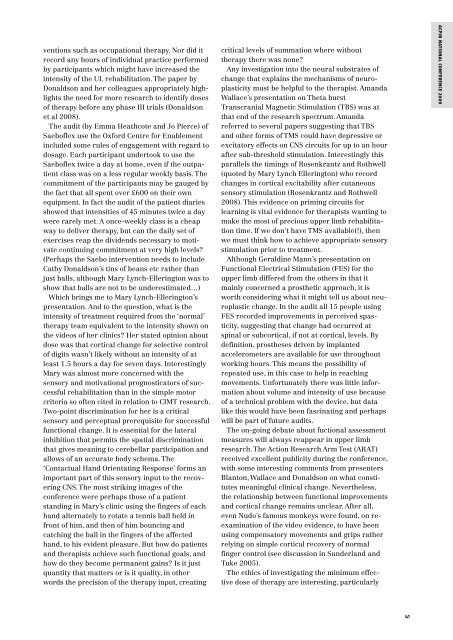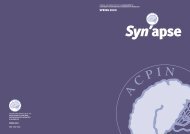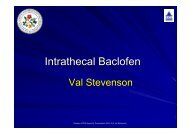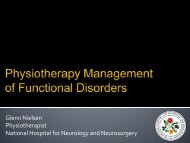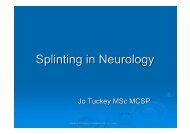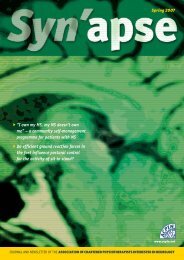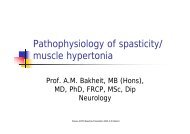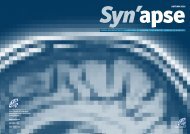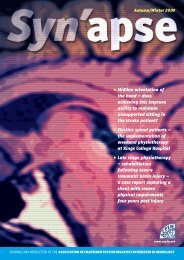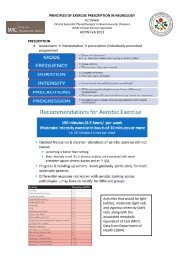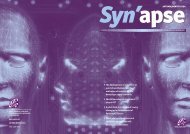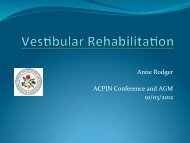SYNAPSE Spring 2009 - acpin
SYNAPSE Spring 2009 - acpin
SYNAPSE Spring 2009 - acpin
You also want an ePaper? Increase the reach of your titles
YUMPU automatically turns print PDFs into web optimized ePapers that Google loves.
ventions such as occupational therapy. Nor did it<br />
record any hours of individual practice performed<br />
by participants which might have increased the<br />
intensity of the UL rehabilitation. The paper by<br />
Donaldson and her colleagues appropriately highlights<br />
the need for more research to identify doses<br />
of therapy before any phase III trials (Donaldson<br />
et al 2008).<br />
The audit (by Emma Heathcote and Jo Pierce) of<br />
Saeboflex use the Oxford Centre for Enablement<br />
included some rules of engagement with regard to<br />
dosage. Each participant undertook to use the<br />
Saeboflex twice a day at home, even if the outpatient<br />
class was on a less regular weekly basis. The<br />
commitment of the participants may be gauged by<br />
the fact that all spent over £600 on their own<br />
equipment. In fact the audit of the patient diaries<br />
showed that intensities of 45 minutes twice a day<br />
were rarely met. A once-weekly class is a cheap<br />
way to deliver therapy, but can the daily set of<br />
exercises reap the dividends necessary to motivate<br />
continuing commitment at very high levels?<br />
(Perhaps the Saebo intervention needs to include<br />
Cathy Donaldson’s tins of beans etc rather than<br />
just balls, although Mary Lynch-Ellerington was to<br />
show that balls are not to be underestimated…)<br />
Which brings me to Mary Lynch-Ellerington’s<br />
presentation. And to the question, what is the<br />
intensity of treatment required from the ‘normal’<br />
therapy team equivalent to the intensity shown on<br />
the videos of her clinics? Her stated opinion about<br />
dose was that cortical change for selective control<br />
of digits wasn’t likely without an intensity of at<br />
least 1.5 hours a day for seven days. Interestingly<br />
Mary was almost more concerned with the<br />
sensory and motivational prognosticators of successful<br />
rehabilitation than in the simple motor<br />
criteria so often cited in relation to CIMT research.<br />
Two-point discrimination for her is a critical<br />
sensory and perceptual prerequisite for successful<br />
functional change. It is essential for the lateral<br />
inhibition that permits the spatial discrimination<br />
that gives meaning to cerebellar participation and<br />
allows of an accurate body schema. The<br />
‘Contactual Hand Orientating Response’ forms an<br />
important part of this sensory input to the recovering<br />
CNS. The most striking images of the<br />
conference were perhaps those of a patient<br />
standing in Mary’s clinic using the fingers of each<br />
hand alternately to rotate a tennis ball held in<br />
front of him, and then of him bouncing and<br />
catching the ball in the fingers of the affected<br />
hand, to his evident pleasure. But how do patients<br />
and therapists achieve such functional goals, and<br />
how do they become permanent gains? Is it just<br />
quantity that matters or is it quality, in other<br />
words the precision of the therapy input, creating<br />
critical levels of summation where without<br />
therapy there was none?<br />
Any investigation into the neural substrates of<br />
change that explains the mechanisms of neuroplasticity<br />
must be helpful to the therapist. Amanda<br />
Wallace’s presentation on Theta burst<br />
Transcranial Magnetic Stimulation (TBS) was at<br />
that end of the research spectrum. Amanda<br />
referred to several papers suggesting that TBS<br />
and other forms of TMS could have depressive or<br />
excitatory effects on CNS circuits for up to an hour<br />
after sub-threshold stimulation. Interestingly this<br />
parallels the timings of Rosenkrantz and Rothwell<br />
(quoted by Mary Lynch Ellerington) who record<br />
changes in cortical excitability after cutaneous<br />
sensory stimulation (Rosenkrantz and Rothwell<br />
2008). This evidence on priming circuits for<br />
learning is vital evidence for therapists wanting to<br />
make the most of precious upper limb rehabilitation<br />
time. If we don’t have TMS available(!), then<br />
we must think how to achieve appropriate sensory<br />
stimulation prior to treatment.<br />
Although Geraldine Mann’s presentation on<br />
Functional Electrical Stimulation (FES) for the<br />
upper limb differed from the others in that it<br />
mainly concerned a prosthetic approach, it is<br />
worth considering what it might tell us about neuroplastic<br />
change. In the audit all 15 people using<br />
FES recorded improvements in perceived spasticity,<br />
suggesting that change had occurred at<br />
spinal or subcortical, if not at cortical, levels. By<br />
definition, prostheses driven by implanted<br />
accelerometers are available for use throughout<br />
working hours. This means the possibility of<br />
repeated use, in this case to help in reaching<br />
movements. Unfortunately there was little information<br />
about volume and intensity of use because<br />
of a technical problem with the device, but data<br />
like this would have been fascinating and perhaps<br />
will be part of future audits.<br />
The on-going debate about fuctional assessment<br />
measures will always reappear in upper limb<br />
research. The Action Research Arm Test (ARAT)<br />
received excellent publicity during the conference,<br />
with some interesting comments from presenters<br />
Blanton, Wallace and Donaldson on what constitutes<br />
meaningful clinical change. Nevertheless,<br />
the relationship between functional improvements<br />
and cortical change remains unclear. After all,<br />
even Nudo’s famous monkeys were found, on reexamination<br />
of the video evidence, to have been<br />
using compensatory movements and grips rather<br />
relying on simple cortical recovery of normal<br />
finger control (see discussion in Sunderland and<br />
Tuke 2005).<br />
The ethics of investigating the minimum effective<br />
dose of therapy are interesting, particularly<br />
ACPIN NATIONAL CONFERENCE <strong>2009</strong><br />
41


